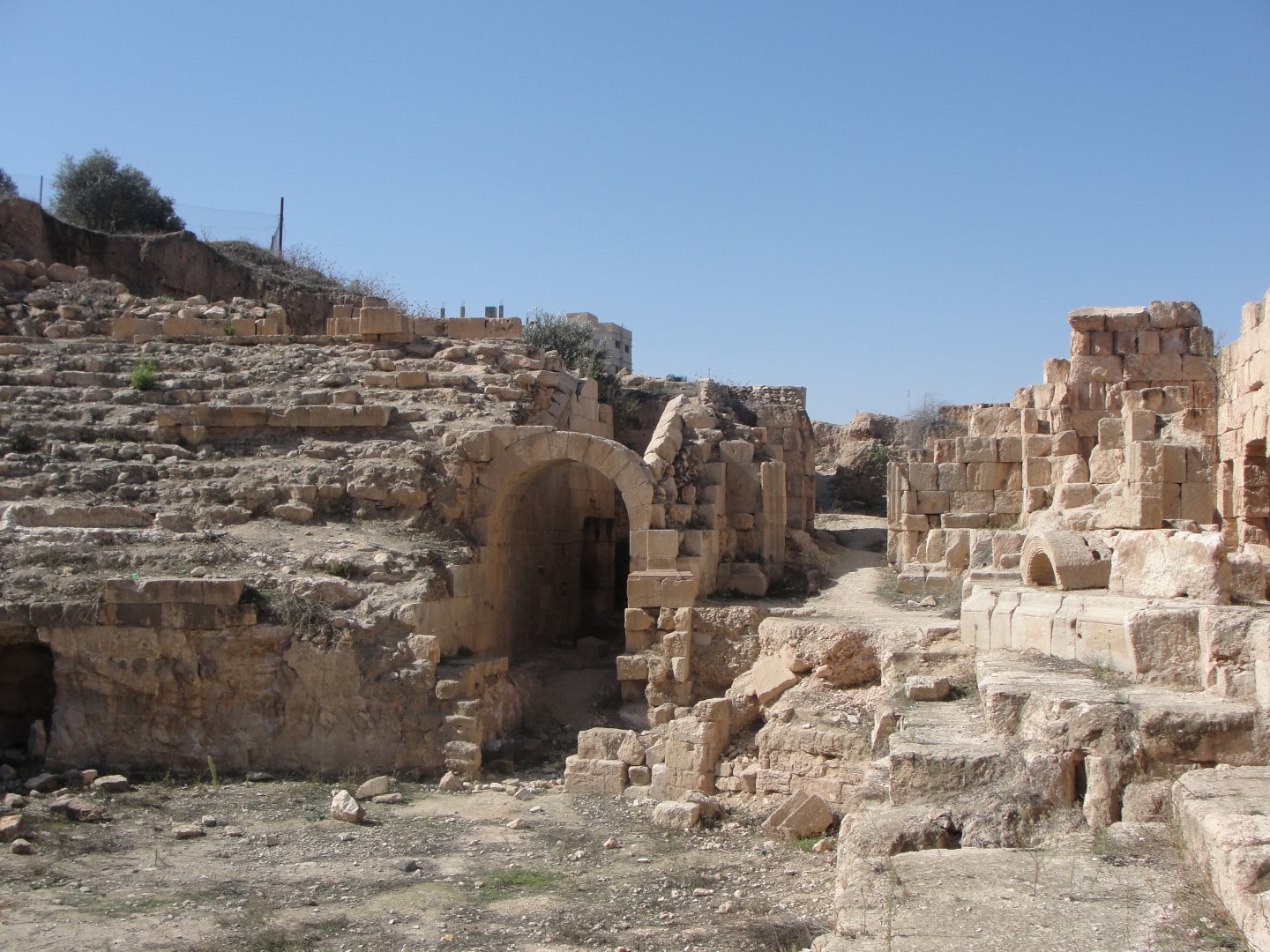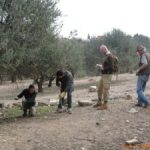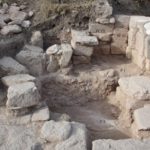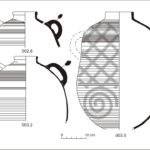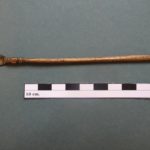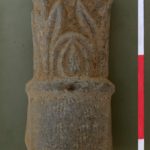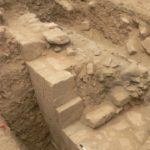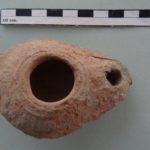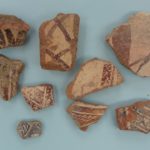Beit Ras
Ancient name: Capitolias
-
Project name:
Beit Ras (Capitolias): an archaeological project
-
Type of site:
Ancient city; area of industrial activity
Location:
Jordan
Near the city of Irbid (ancient Arbela) in northern Jordan
Biblical region of Gilead, between the rivers Arnon and JarmukDating:
– Roman period (1st–4th century AD)
– Byzantine period (5th–6th/7th century AD)
– early Islamic/Umayyad period (7th–8th century AD)
– early medieval period (Abbasid, Fatimid and Ayyubid periods, 9th–half of 13th century AD)
Most interesting finds:
– city defense wall (2nd–8th? century AD)
– winery (6th–7th century AD)
– area of industrial activity (installations connected with the production of wine, pottery and glass objects, as well as cisterns: Byzantine and Umayyad periods)
– architectural elements from the nearby church which had probably been destroyed by the Persians (AD 614)
History of research:
Investigated by the PCMA mission in:
2014–2016
Type of research:
geophysical survey, excavations
Directors:
Jolanta Młynarczyk (Institute of Archaeology, University of Warsaw)
Co-operating institutions:
– Polish Centre of Mediterranean Archaeology, University of Warsaw
– Institute of Archaeology, University of Warsaw
– Department of Antiquities of Jordan
Additional information:
Archaeological excavations of the site began in the 1980s (C.J. Lenzen, Joint Excavation Project, with the participation of the Yarmouk University, Irbid and the Department of Antiquities of Jordan). The Polish mission started its research at the site in 2014 (electrical resistivity survey); in the following seasons (2015, 2016), archaeological excavations were conducted in two separate areas.
Description of the site and research:
At the site of the present-day town of Beit Ras there existed in antiquity the city of Capitolias, founded probably in the 1st century AD. In the Roman, Byzantine and early Islamic periods, from the 1st to the 8th century AD, Capitolias was among the most important towns of Syro-Palestine. Ancient sources mention that it belonged to the so-called Decapolis, a group of cities of Graeco-Roman character. Today, the area of Capitolias is covered with modern architecture, with the exception of a small part directly to the west of an imposing Roman-period theater (built in the 2nd century AD and undoubtedly functioning until the end of the Byzantine period), lying on the northern slope of the plateau occupied once by the ancient city and now by the modern town.
Since there were no structures in this area (only an olive grove), it was possible to gain knowledge about the last accessible part of ancient Capitolias, which functioned – in a different form and under a new name (Beit Ras) – until the late medieval period.
In one of the trenches, a mosaic-paved stone basin was found. It was divided into compartments by low walls and belonged to a winery. According to Arabic literary sources from the 6th–8th century, Beit Ras – Kapitolias was famous in the Byzantine and early Islamic periods for the wine it produced. The winery was established most probably in the Byzantine period (6th century?), but broken fragments of amphorae found nearby indicate that wine must have been produced in the vicinity at least until the half of the 8th century.
Not far from the winery basin, a rock-cut cistern was found, dating probably to the 6th century AD. It was in use for several centuries, as attested by the presence of fragments of early medieval pottery from the 9th–10th century AD. A fragment of a marble slab from the chancel screen of the church, remains of which are partially visible on the edge of the plateau above the winery, was found among the reused stone elements used in the casing of the cistern. An even more unique find from the winery basin, coming undoubtedly from this very church, was a miniature bronze spoon used probably for administering communion. Other elements of the church furnishings found nearby included a small marble column from the chancel and a fragment of a large marble tray. These discoveries confirm the earlier suggestions that the church had been destroyed, most probably during a Persian raid in the first quarter of the 7th century,
During the excavations, a 4-m-long section of the city defense wall, marking the northern limit of Capitolias, was also discovered. Fragments of pottery vessels found nearby prove that it was built in the Roman period, not later than the 2nd century AD. In the area adjoining the wall on the city side fragments of clay installations (production ovens?), as well as metal, glass(?) and pottery wasters were discovered. These finds point to the industrial character of this part of the town, not only in Byzantine times but also in the earlier (Roman) period.
The urbanization of this part of Capitolias ended probably in AD 749 with the catastrophic earthquake, after which the area was used only as a source of building material and grazing land. Rock-cut water cisterns (of Byzantine, or maybe even Roman origin) were used for several centuries, probably until the medieval period, for agriculture and pasture.
Seasons’ results:
Press releases and media information:
2016 November: Polscy archeolodzy pracują w Jordanii od ponad 30 lat (Polish archaeologists have been working in Jordan for 30 years – in Polish)
2016 June: Polacy odkopali winiarnię (Poles have discovered a winery – in Polish)
2015 August: Polscy archeolodzy poznają przeszłość Kapitolias (Polish archaeologists are discovering the past of Capitolias – in Polish])
2015 May: Polskie wykopaliska archeologiczne w Beit Ras (Polish archaeological excavations at Beit Ras – in Polish)
2014 December: Polish archaeologists in the ancient city of Jupiter Capitolinus
2014 December: New Polish–Jordanian archaeological project in Beit Ras
Burdajewicz, M. (in press). Glass finds from Beit Ras, ancient Capitolias of the Decapolis. Recent Discoveries, Annual of the Department of Antiquities in Jordan.
Młynarczyk, J. (in press). Archaeological investigations in Beit Ras, ancient Capitolias, 2015: Preliminary report, Annual of the Department of Antiquities in Jordan.
Burdajewicz, M. (2017). Glass finds from Beit Ras/Capitolias (Jordan), Polish Archaeology in the Mediterranean, 26/1, 661–686.
Młynarczyk, J. (2017). Beit Ras/Capitolias: an archaeological project 2014–2016, Polish Archaeology in the Mediterranean, 26/1, 475–506.
Selected bibliography of the site:
Al-Shami, A.J. (2005). A new discovery at Bayt Ras/Capitolias – Irbid. Annual of the Department of Antiquities in Jordan, 49, 509–519
Lenzen, C.J. (2003). Ethnic identity at BeitRas/Capitolias and Umm al-Jimal. Mediterranean Archaeology, 16, 73–87
Lenzen, C.J. (2002). Kapitolias – Die vergessene Stadt im Norden. In A. Hoffmann and S. Kerner (eds), Gadara – Gerasa und die Dekapolis (pp. 36–44). Mainz am Rhein: Philip von Zabern Verlag
Lenzen, C.J. (1995). From public to private space: Changes in the urban plan of Bayt Rās/Capitolias. In Studies in the History and Archaeology of Jordan V (pp. 235–239). Amman
Lenzen C.J. (1990). Beit Ras Excavations: 1988–1989, Chronique archéologique. Syria, 67, 474–476
Lenzen, C.J. and McQuitty, A.M. (1988). The 1984 survey of the Irbid/Beit Ras Region. Annual of the Department of Antiquities in Jordan, 32, 265–269
Lenzen, C.J. and Knauf, E.A. (1987). Beit Ras/Kapitolias. A preliminary evaluation of the archaeological and textual evidence. Syria, 64, 21–46
Lenzen, C.J., McQuitty, A.M., and Gordon, R.L. (1986). Tell Irbid and Beit Ras excavations 1985. Annual of the Department of Antiquities in Jordan, 29, 151–159
Peeters, P. (1939). La passion de S. Pierre de Capitolias (+ 13 janvier 715). Analecta Bollandiana, 57, 299–333
Schumacher, G. (1890). Northern ‘Ajlun. London: Palestine Exploration Fund
Gallery:
-
1. First season of work in Beit Ras, 2014: electric resistivity survey / Pierwszy sezon prac w Beit Ras, 2014: badania elektrooporowe (fot. J. Młynarczyk).
-
2. Floors and walls from the Byzantine and Umayyad periods on the northern slope of the Beit Ras plateau / Podłogi i mury z okresów bizantyjskiego i omajadzkiego na północnym stoku płaskowyżu Beit Ras (fot. M. Burdajewicz).
-
3. Western edge of the mosaic-paved winery basin, Byzantine period / Zachodnia krawędź basenu winiarni wyłożonego mozaiką, okres bizantyjski (fot. M. Burdajewicz).
-
4. Wine amphorae from a deposit discovered under a floor near the winery, 7th century AD / Amfory na wino z depozytu odkrytego nad podłogą w rejonie winiarni, VII wiek n.e. (rys. M. Burdajewicz).
-
5. Uncovering of a Byzantine cistern; the casing was added later, probably in the early medieval period / Odsłanianie bizantyjskiej cysterny z cembrowiną dobudowaną w okresie późniejszym, prawdopodobnie wczesnośredniowiecznym (fot. M. Burdajewicz).
-
6. Miniature bronze spoon (BR 2016/11/5), 6th century AD / Miniaturowa łyżeczka z brązu (BR 2016/11/5), VI wiek n.e. (fot. J. Młynarczyk).
-
7. Fragment of a small marble column (BR 2015/19/20) from the presbytery of a nearby church, 6th century AD / Fragment marmurowej kolumienki (BR 2015/19/20) z prezbiterium pobliskiego kościola, VI wiek n.e. (fot. M. Burdajewicz).
-
8. Northern stretch of the defense wall of Capitolias, built in the 1st/2nd century AD / Północny odcinek obronnego muru Kapitolias, zbudowanego w I/II wieku n.e. (fot. M. Drzewiecki).
-
9. Terracotta oil lamp produced in a local workshop in Capitolias in the 6th century AD / Terakotowa lampka oliwna wykonana w miejscowym warsztatcie Kapitolias w VI wieku n.e. (fot. M. Burdajewicz).
-
10. Fragments of painted Mamluk pottery, 12th century AD / Fragmenty malowanej ceramiki mameluckiej, XII wiek n.e. (fot. J. Młynarczyk).


